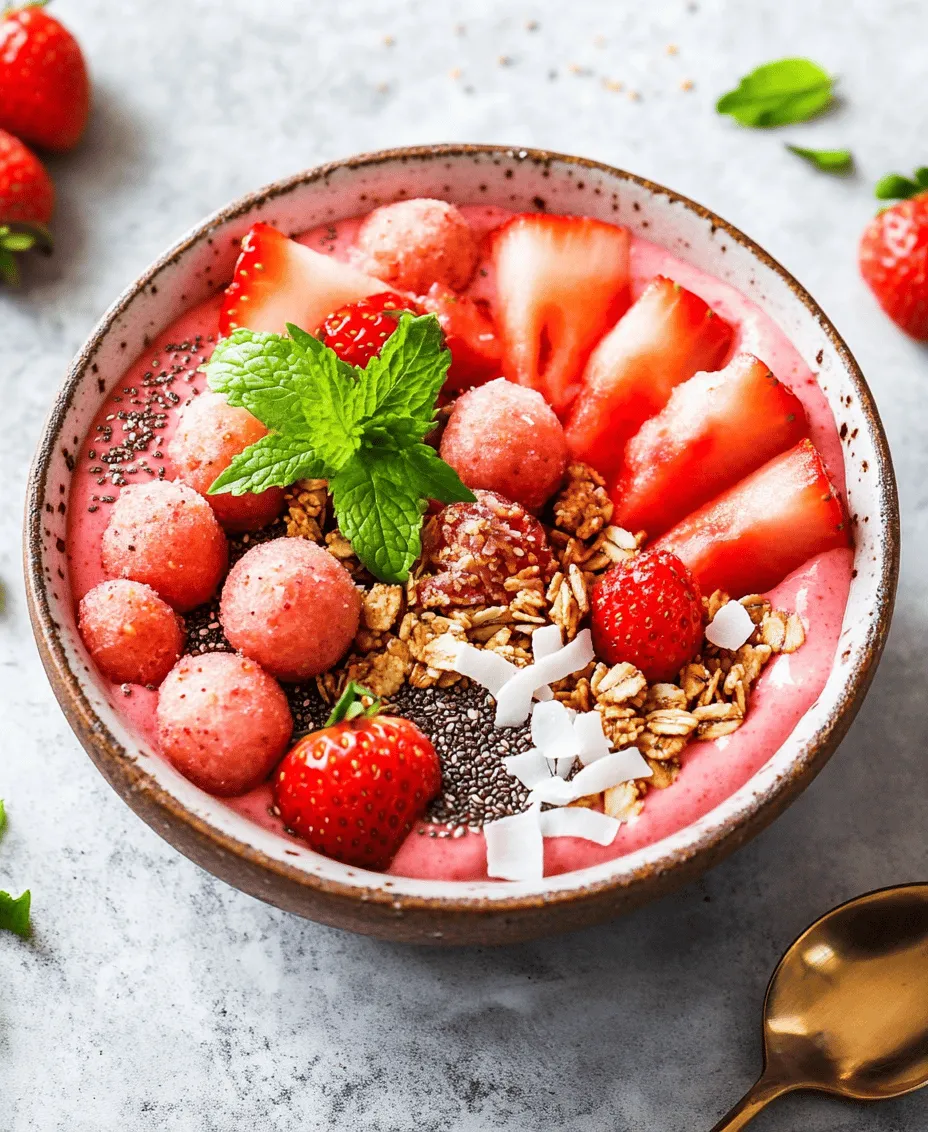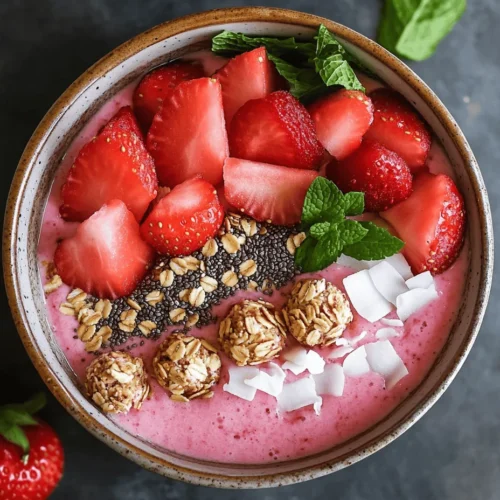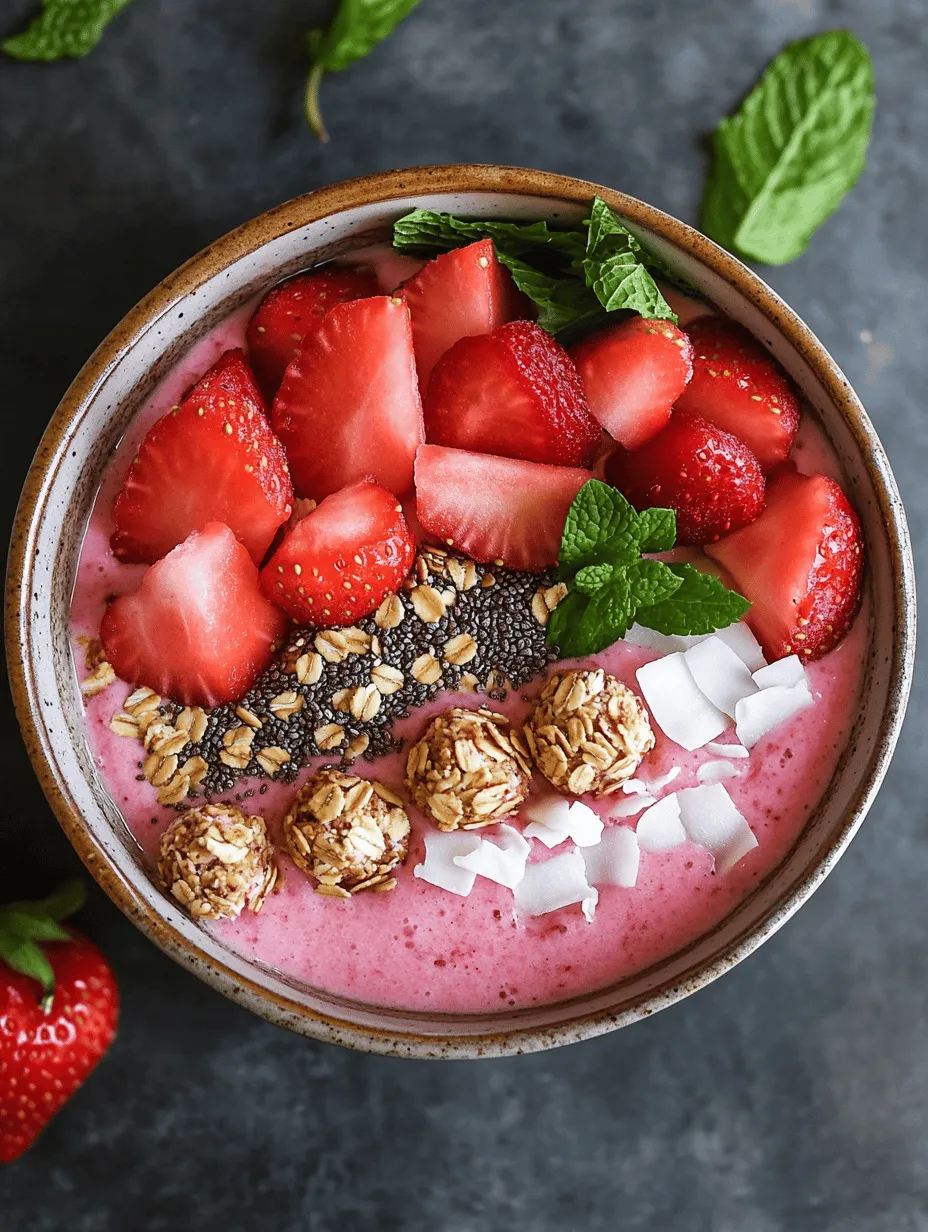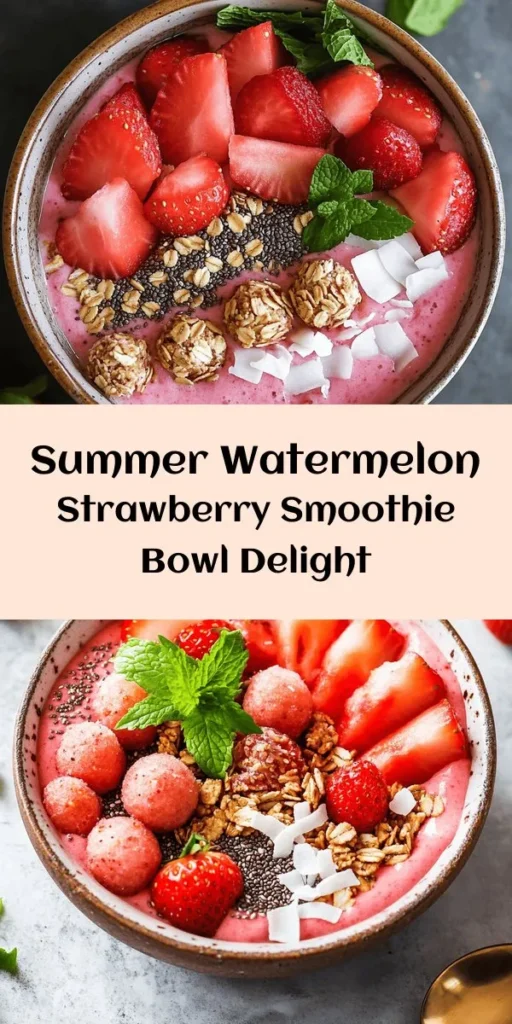Introduction
In recent years, smoothie bowls have taken the culinary world by storm, transforming the way we think about breakfast and snacks. These colorful, nutrient-packed bowls are not just visually appealing; they offer a powerful way to incorporate a variety of fresh fruits into our diets. With their creamy textures and vibrant colors, smoothie bowls have become a staple for health enthusiasts and foodies alike, providing a refreshing alternative to traditional smoothies.
One standout recipe that perfectly embodies this trend is the Refreshing Watermelon and Strawberry Smoothie Bowl. This delightful concoction marries the sweet, hydrating qualities of watermelon with the tartness of ripe strawberries, creating a refreshing and nutritious meal option that is perfect for hot summer days or any time you crave something light and fruity. Not only does it taste amazing, but it also packs a punch of vitamins and antioxidants, making it a smart choice for breakfast, snacks, or even dessert.
The appeal of this smoothie bowl lies not only in its vibrant colors and delicious taste but also in its versatility. Easy to customize and adaptable to various dietary preferences, the Watermelon and Strawberry Smoothie Bowl can be topped with a myriad of ingredients like nuts, seeds, granola, or additional fruits, allowing each person to make it their own. This healthy and satisfying meal will not only energize your day but also leave you feeling refreshed and nourished.
Understanding Smoothie Bowls
Definition and Origin of Smoothie Bowls
Smoothie bowls, as the name suggests, are thick smoothies served in a bowl and typically topped with various ingredients, transforming an ordinary drink into an engaging and visually appealing meal. The concept of smoothie bowls is believed to have originated in Hawaii, where locals would blend fresh fruits, vegetables, and superfoods into a thick puree, then serve it in bowls adorned with colorful toppings. Over the years, this trend has spread globally, becoming a popular choice for breakfast and healthy snacking, particularly among those who appreciate the aesthetics of food.
Nutritional Benefits of Smoothie Bowls Compared to Traditional Smoothies
One of the main advantages of smoothie bowls over traditional smoothies is their texture. The thicker consistency of smoothie bowls allows for a more satisfying eating experience, as toppings add a delightful crunch and variety in flavors. This combination makes smoothie bowls not only more enjoyable to eat but also more filling, making it easier to incorporate a well-rounded meal into your diet.
Additionally, smoothie bowls can be more nutritious than their liquid counterparts. When prepared with whole fruits and vegetables, they retain more fiber, which is essential for digestive health. Fiber helps to slow down the absorption of sugars into the bloodstream, keeping you fuller for longer and aiding in weight management. By choosing whole ingredients, you can create a nutrient-dense meal that supports overall health.
The Versatility in Flavors and Textures of Smoothie Bowls
Another appealing aspect of smoothie bowls is their incredible versatility. You can mix and match various fruits, vegetables, and toppings to create an endless array of flavors and textures. The base can be tailored to fit your preferences, whether you lean towards tropical fruits like mango and pineapple or prefer a berry medley. The toppings are equally limitless—granola, nuts, seeds, coconut flakes, and fresh herbs all contribute unique flavors and nutrients, allowing you to get creative with your presentation.
Furthermore, smoothie bowls can cater to various dietary needs; they can be made vegan, gluten-free, or nut-free, depending on the ingredients chosen. This adaptability makes smoothie bowls an excellent choice for anyone looking to enhance their diet in a delicious and enjoyable way.
Key Ingredients and Their Benefits
To create the Refreshing Watermelon and Strawberry Smoothie Bowl, you will need a few key ingredients, each offering its own unique benefits:
Fresh Watermelon
Watermelon serves as the base of this smoothie bowl, providing a refreshing and hydrating component. This juicy fruit is composed of about 92% water, making it an excellent choice for hydration, particularly during hot summer days. Watermelon is also rich in vitamins A and C, which are essential for maintaining healthy skin and supporting the immune system. Additionally, it contains antioxidants like lycopene, which may help reduce inflammation and promote heart health.
Ripe Strawberries
Ripe strawberries add a burst of flavor and color to the smoothie bowl. These vibrant berries are not only delicious but also packed with nutrients. Strawberries are an excellent source of vitamin C, manganese, and antioxidants, which play a crucial role in fighting free radicals in the body. The fiber content in strawberries supports digestive health and helps regulate blood sugar levels, making them a fantastic addition to any meal.
Frozen Banana
Frozen bananas are essential for achieving a creamy texture in your smoothie bowl. When blended, they create a thick, luscious base that makes the smoothie feel indulgent without the need for added sugars or heavy ingredients. Bananas are also a great source of potassium, which is important for maintaining healthy blood pressure and muscle function. Their natural sweetness helps balance the tartness of the strawberries while contributing to the overall flavor.
Coconut Milk
To enhance creaminess and add a touch of tropical flavor, coconut milk is used in this recipe. As a dairy-free alternative, coconut milk is perfect for those following a vegan or lactose-free diet. It contains healthy fats that can provide sustained energy and support heart health. Additionally, coconut milk is a good source of vitamins C, E, and several B vitamins, making it a nutritious choice for your smoothie bowl.
Sweeteners: Honey vs. Maple Syrup
Depending on your taste preferences, you can sweeten your smoothie bowl with either honey or maple syrup. Both options offer natural sweetness, but they come with different nutritional profiles. Honey is known for its antibacterial properties and can provide a quick energy boost due to its simple sugars. On the other hand, maple syrup is rich in antioxidants and contains minerals like manganese and zinc. When choosing a sweetener, consider your dietary needs and taste preferences.
Chia Seeds
Chia seeds are a nutritional powerhouse that adds both texture and health benefits to your smoothie bowl. These tiny seeds are incredibly rich in omega-3 fatty acids, fiber, and protein. When soaked, they expand and create a gel-like consistency, making them perfect for adding thickness to your smoothie bowl. Additionally, the fiber in chia seeds promotes digestive health and helps keep you feeling full longer.
Fresh Mint
Finally, fresh mint leaves not only add a pop of color and visual appeal but also impart a refreshing aroma and flavor to your smoothie bowl. Mint is known for its digestive properties and can help soothe an upset stomach. Its vibrant flavor can elevate the overall taste of your smoothie bowl, making it even more enjoyable.
Preparation Steps
Now that we’ve covered the key ingredients and their benefits, it’s time to dive into the preparation process for the Refreshing Watermelon and Strawberry Smoothie Bowl. The following steps will guide you through creating this delicious and nutritious meal:
1. Gather All Ingredients: Before starting, make sure you have all the ingredients ready. You will need fresh watermelon, ripe strawberries, a frozen banana, coconut milk, sweetener (honey or maple syrup), chia seeds, and fresh mint for garnish.
2. Prepare the Fruits: Start by cutting the watermelon into cubes, removing any seeds. Make sure to measure out approximately two cups of watermelon for the smoothie base. Next, wash the strawberries thoroughly, removing the stems and slicing them in half to make blending easier.
3. Blend the Smoothie: In a high-speed blender, add the watermelon cubes, halved strawberries, frozen banana, and coconut milk. If you prefer a sweeter smoothie, include your chosen sweetener at this stage. Blend on high until the mixture is smooth and creamy, ensuring there are no chunks remaining.
4. Adjust Consistency: If the smoothie is too thick for your liking, you can add a little more coconut milk until you reach your desired consistency. For a thicker bowl, use less liquid.
5. Add Chia Seeds: Once blended, stir in a tablespoon of chia seeds. Allow the mixture to sit for a few minutes to let the chia seeds expand and thicken the smoothie further.
6. Assemble the Bowl: Pour the smoothie mixture into a bowl, creating a smooth and even surface. Now comes the fun part—topping your smoothie bowl!
7. Add Toppings: Top your smoothie bowl with sliced strawberries, watermelon cubes, and a sprinkle of chia seeds for added texture. You can also include granola, nuts, or coconut flakes to enhance the flavors and provide a satisfying crunch.
8. Garnish with Fresh Mint: Finish your smoothie bowl with fresh mint leaves for an extra burst of freshness and visual appeal.
This Refreshing Watermelon and Strawberry Smoothie Bowl is not only a feast for the eyes but also a delicious and healthy way to start your day or recharge your energy during the day. With its vibrant colors, refreshing flavors, and wholesome ingredients, it’s sure to become a favorite in your recipe repertoire.
Stay tuned for the next part of this article, where we will dive deeper into tips for the best results and answer common questions about smoothie bowls!

Importance of Using Fresh Ingredients
When it comes to making a Refreshing Watermelon and Strawberry Smoothie Bowl, the quality of your ingredients plays a crucial role in the overall taste and nutritional value. Fresh fruits not only enhance the flavor but also contribute essential vitamins, minerals, and antioxidants that can boost your health. Opting for ripe, seasonal watermelon and strawberries ensures your smoothie bowl is bursting with natural sweetness and vibrant flavor.
Fresh ingredients also provide a better texture, vital for achieving that creamy smoothie consistency. When you use fruits that are at their peak ripeness, you can maximize the natural sugars, resulting in a more flavorful dish without the need for added sweeteners. Additionally, fresh produce tends to have a higher nutrient density, offering more health benefits compared to frozen or overly processed alternatives.
The Significance of Blending Techniques for Texture
Achieving the perfect texture in your smoothie bowl is an art that involves understanding proper blending techniques. Start by adding your liquid ingredients—such as coconut water, almond milk, or yogurt—before your fruits. This method ensures a smooth blend, allowing the blades to easily break down the fruit fibers.
When blending, use a high-speed blender to achieve a creamy consistency without any chunks. Pulse the mixture initially to break the ingredients down, then blend on high speed until smooth. If your smoothie is too thick, you can add a splash more liquid, but be cautious not to overdo it, as this can dilute the flavor. For a thicker consistency, consider freezing your fruits beforehand or adding a bit of ice. The right blending technique not only affects the texture but can also influence the overall experience of enjoying your smoothie bowl.
Tips for Achieving a Perfectly Creamy Consistency
To create a smoothie bowl that is both thick and creamy, there are several tips to keep in mind:
1. Use Frozen Fruits: If you prefer a super creamy texture, using frozen strawberries and watermelon can help achieve that desired thickness. This technique also keeps your smoothie bowl chilled without needing extra ice.
2. Incorporate a Creamy Base: Adding a scoop of Greek yogurt or a banana can enhance the creaminess. Greek yogurt also brings added protein, making your smoothie bowl more filling.
3. Control the Liquid: Begin with a small amount of liquid and gradually add more as needed. This way, you maintain control over the thickness of your smoothie.
4. Blend in Stages: Blend your fruits in stages rather than dumping everything in at once. Start with the liquids and some of the fruits, then add the rest to ensure everything is integrated smoothly.
5. Let It Rest: After blending, let the smoothie sit for a minute before serving. This allows air bubbles to rise, resulting in a smoother texture.
How to Adjust Sweetness Levels According to Personal Preference
One of the great aspects of making a smoothie bowl is the ability to tailor it to your taste. If you prefer a sweeter bowl, consider these options:
– Natural Sweeteners: Honey, maple syrup, or agave nectar can be drizzled in for added sweetness. Start with a teaspoon, blend, and taste before adding more.
– Ripe Fruits: Using very ripe fruits naturally increases sweetness. Look for strawberries that are deep red and watermelon that has a rich pink color.
– Flavorful Additions: Ingredients like vanilla extract, cinnamon, or a splash of orange juice can enhance sweetness without adding extra sugar.
– Taste Test: Always taste your smoothie before serving and adjust as necessary. It’s easier to add sweetness than to remove it.
Creative Toppings for Your Smoothie Bowl
Toppings are not just an aesthetic addition; they play an important role in enhancing both the flavor and texture of your smoothie bowl. A well-topped smoothie bowl can elevate your dish from simple to extraordinary.
Importance of Toppings in Enhancing Flavor and Texture
Toppings add a delightful crunch or creaminess that perfectly complements the smooth base. They also introduce different flavors, offering a variety of taste experiences with each bite. Moreover, toppings can boost the nutritional profile of your meal, providing additional vitamins, minerals, and healthy fats.
Suggestions for Toppings
Here are some topping ideas that will make your Watermelon and Strawberry Smoothie Bowl even more exciting:
– Sliced Strawberries: Fresh slices add a burst of flavor and a pop of color. They are low in calories and rich in antioxidants.
– Watermelon Balls: Using a melon baller to create small, round pieces of watermelon adds a playful element while providing hydration and vitamins.
– Granola: A sprinkle of granola introduces a satisfying crunch. Select a low-sugar, whole-grain variety for added fiber.
– Coconut Flakes: Unsweetened coconut flakes not only add texture but also contribute healthy fats and a tropical twist.
– Chia Seeds: These tiny seeds are packed with omega-3 fatty acids, fiber, and protein. They can absorb liquid and expand, adding a nutritious element to your bowl.
Nutritional Contributions of Each Topping
– Sliced Strawberries: High in vitamin C and manganese, strawberries support immune function and skin health.
– Watermelon Balls: Watermelon is hydrating and low in calories, making it a great addition for hydration and weight management.
– Granola: Provides complex carbohydrates and fiber, keeping you full and satisfied longer.
– Coconut Flakes: Rich in medium-chain triglycerides (MCTs), coconut can support energy levels and metabolism.
– Chia Seeds: High in fiber, protein, and omega-3s, chia seeds promote heart health and digestive wellness.
Ideas for Seasonal or Themed Toppings
Take your smoothie bowl to the next level by incorporating seasonal toppings. In the summer, consider adding fresh blueberries or peaches, while in the fall, opt for spiced pumpkin seeds or pecans. For a festive touch during the holidays, pomegranate seeds would add a beautiful pop of red and a tart flavor.
Serving Suggestions
Your Refreshing Watermelon and Strawberry Smoothie Bowl is versatile and can be enjoyed in various settings. Here are some ideal occasions and presentation tips:
Ideal Occasions to Serve the Smoothie Bowl
– Breakfast: Kickstart your day with a nutrient-packed breakfast that energizes you.
– Brunch: Impress your guests at brunch gatherings with this vibrant and healthy dish.
– Snack: This smoothie bowl makes for a refreshing midday snack, perfect for when you need a boost.
Presentation Ideas for a Visually Appealing Dish
To make your smoothie bowl visually appealing:
– Use a Wide Bowl: Serve in a shallow, wide bowl to showcase your toppings beautifully.
– Artful Arrangement: Arrange your toppings in a circular pattern or in sections to create an inviting look.
– Color Contrast: Incorporate a variety of colors in your toppings to make the dish pop visually.
Pairing Suggestions
Pair your smoothie bowl with a cup of herbal tea or a rich cup of coffee. The warmth of tea can balance the coolness of the smoothie, and coffee can add a nice caffeine boost to your morning routine.
Nutritional Analysis
Understanding the nutritional content of your Refreshing Watermelon and Strawberry Smoothie Bowl can help you appreciate its health benefits.
Breakdown of Nutritional Content Per Serving
A typical serving of this smoothie bowl (without toppings) contains approximately:
– Calories: 150-200, depending on the ingredients used.
– Carbohydrates: 30-35 grams, mainly from natural sugars in the fruits.
– Protein: 2-5 grams, depending on whether you added yogurt or protein powder.
– Fat: 0-5 grams, depending on your toppings.
Discussion on How This Recipe Fits Into a Balanced Diet
This smoothie bowl is not only delicious but also a great source of vitamins A and C, potassium, and fiber. It fits well into a balanced diet, serving as a nutritious breakfast or snack option. The combination of fruits provides natural energy, while the potential protein additions can help with muscle recovery and satiety.
Potential Dietary Restrictions and Modifications Available
This recipe is inherently gluten-free and can easily be made dairy-free by using plant-based yogurt. For those watching their sugar intake, consider using less fruit or opting for lower-sugar fruits like berries. Adjust the toppings to fit various dietary needs, such as nut-free granola for those with nut allergies.
Environmental and Economic Considerations
Using seasonal and local produce not only supports your health but also benefits the environment and your wallet.
Benefits of Using Seasonal and Local Produce
Seasonal fruits are typically fresher and have a lower environmental impact due to reduced transportation emissions. Local farmers often use sustainable practices, ensuring that your ingredients are not only nutritious but also eco-friendly.
Cost-Effective Shopping Tips for Fruits and Ingredients
To save money while shopping for your smoothie bowl ingredients:
– Buy in Bulk: Purchase fruits in bulk, especially during peak season when prices drop.
– Visit Farmers’ Markets: Local markets often offer fresher produce at competitive prices.
– Choose Frozen Options: Frozen fruits can be more affordable and have a longer shelf life, reducing waste.
Reducing Food Waste with Creative Uses for Leftover Ingredients
If you have leftover ingredients, consider making popsicles with extra smoothie mixture or using leftover fruits in baking. This helps minimize waste while allowing you to enjoy your ingredients in multiple ways.
Conclusion
The Refreshing Watermelon and Strawberry Smoothie Bowl is more than just a treat; it is a nutritious meal that can easily fit into your daily routine. With its vibrant colors, delicious flavors, and endless topping possibilities, this smoothie bowl is bound to become a favorite.
Encourage yourself to experiment with different fruits and toppings to personalize your bowl. By incorporating more nutritious meals into your daily life, you can enjoy the benefits of a balanced diet while exploring the deliciousness of wholesome ingredients. So, grab your blender and get creative—your perfect smoothie bowl awaits!



